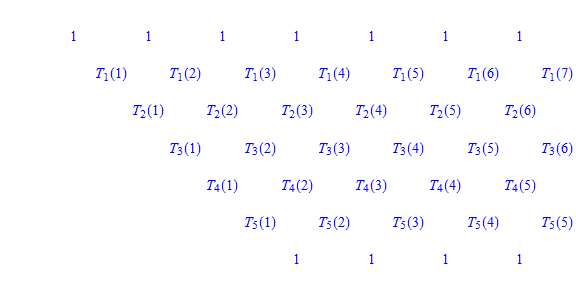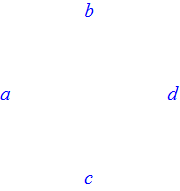"콕세터 프리즈"의 두 판 사이의 차이
둘러보기로 가기
검색하러 가기
Pythagoras0 (토론 | 기여) |
Pythagoras0 (토론 | 기여) |
||
| (같은 사용자의 중간 판 13개는 보이지 않습니다) | |||
| 1번째 줄: | 1번째 줄: | ||
==개요== | ==개요== | ||
| − | * 자연수 | + | * <math>r</math> : 자연수 |
| − | * | + | * <math>I=\{1\,\cdots, r\}</math> |
| + | * 복소수 <math>T_{m}(u)</math>, <math>u\in \mathbb{Z}_{\geq 0}</math>, <math>m\in I</math>에 대하여, 다음과 같은 점화식을 생각하자 | ||
\begin{equation} | \begin{equation} | ||
\label{cf} | \label{cf} | ||
\left\{ | \left\{ | ||
\begin{array}{lll} | \begin{array}{lll} | ||
| − | + | T_{0}(u) =T_{r+1}(u) =1 & u\in \mathbb{Z}_{\geq 0} \\ | |
| − | + | T_{m}(u)T_{m}(u+1)=1+T_{m-1}(u+1)T_{m+1}(u) & m\in I, u\in \mathbb{Z}_{\geq 0} | |
\end{array} | \end{array} | ||
\right. | \right. | ||
\end{equation} | \end{equation} | ||
| − | * 아래의 그림은 | + | * 아래의 그림은 <math>r=5</math>인 경우에 해당하며, <math>\left(T_{m}(1)\right)_{m\in I}</math>가 결정되면, 나머지 <math>T_{m}(u)</math>는 점화식 \ref{cf}로부터 얻어진다 |
[[파일:콕세터 프리즈1.png]] | [[파일:콕세터 프리즈1.png]] | ||
| − | * 점화식 \ref{cf}은 다음과 같은 배열이 | + | * 점화식 \ref{cf}은 다음과 같은 배열이 <math>ad-bc=1</math>를 만족시키는 것으로 이해할 수 있다 |
[[파일:콕세터 프리즈5.png]] | [[파일:콕세터 프리즈5.png]] | ||
==예== | ==예== | ||
| + | ===<math>r=2</math>=== | ||
| + | * [[5항 관계식 (5-term relation)]] | ||
| + | [[파일:콕세터 프리즈4.png]] | ||
| + | ===<math>r=3</math>=== | ||
| + | [[파일:콕세터 프리즈6.png]] | ||
| + | |||
| + | [[파일:콕세터 프리즈7.png]] | ||
| + | ===<math>r=4</math>=== | ||
[[파일:콕세터 프리즈2.png]] | [[파일:콕세터 프리즈2.png]] | ||
| + | |||
| + | ===<math>r=6</math>=== | ||
| + | [[파일:콕세터 프리즈3.png]] | ||
| + | |||
| + | |||
| + | |||
| − | + | ==성질== | |
| + | ===주기성=== | ||
| + | * 각 <math>m\in I</math>에 대하여, <math>T_{m}(u+(r+3))=T_{m}(u)</math>이 성립한다 | ||
| + | |||
| + | ===정수 수열=== | ||
| + | * 모든 <math>T_{m}(u)</math>, <math>u\in \mathbb{Z}_{\geq 0}</math>, <math>m\in I</math>가 정수가 될 필요충분조건은 다음과 같다 | ||
| + | :<math> | ||
| + | T_{m}(1)|\left(T_{m-1}(1)+T_{m+1}(1)\right) | ||
| + | </math> | ||
| + | ;(정리) 콕세터-콘웨이 | ||
| + | 모든 양의 정수로 이루어진 콕세터 프리즈는 정(r+3)-각형의 삼각화로부터 얻어진다 | ||
| + | '''[H]''' 정리 4 참조 | ||
| − | [[ | + | ==관련된 항목들== |
| + | * [[정다각형의 삼각형 분할]] | ||
| + | * [[패리 수열(Farey series)]] | ||
==매스매티카 파일 및 계산 리소스== | ==매스매티카 파일 및 계산 리소스== | ||
* https://docs.google.com/file/d/0B8XXo8Tve1cxbjhtOHUwbTB1S2s/edit?usp=drivesdk | * https://docs.google.com/file/d/0B8XXo8Tve1cxbjhtOHUwbTB1S2s/edit?usp=drivesdk | ||
| + | |||
| + | |||
| + | ==관련도서== | ||
| + | * Coxeter, H. S. M. 1991. Regular Complex Polytopes. Cambridge [England]; New York: Cambridge University Press. http://www.amazon.com/Regular-Complex-Polytopes-H-Coxeter/dp/0521394902 | ||
| + | ** Chapter 5 | ||
| + | |||
| + | |||
| + | ==리뷰, 에세이, 강의노트== | ||
| + | * Morier-Genoud, Sophie. ‘Coxeter’s Frieze Patterns at the Crossroads of Algebra, Geometry and Combinatorics’. arXiv:1503.05049 Null, 17 March 2015. http://arxiv.org/abs/1503.05049. | ||
| + | |||
==관련논문== | ==관련논문== | ||
| + | * Karin Baur, Klemens Fellner, Mark James Parsons, Manuela Tschabold, Growth behaviour of periodic tame friezes, http://arxiv.org/abs/1603.02127v1 | ||
| + | * '''[H]'''Henry, Claire-Soizic. 2013. “Coxeter Friezes and Triangulations of Polygons.” American Mathematical Monthly 120 (6): 553–558. doi:10.4169/amer.math.monthly.120.06.553. | ||
* Conway, J. H., and H. S. M. Coxeter. 1973. “Triangulated Polygons and Frieze Patterns.” The Mathematical Gazette 57 (400) (June 1): 87–94. doi:10.2307/3615344. | * Conway, J. H., and H. S. M. Coxeter. 1973. “Triangulated Polygons and Frieze Patterns.” The Mathematical Gazette 57 (400) (June 1): 87–94. doi:10.2307/3615344. | ||
* Conway, J. H., and H. S. M. Coxeter. 1973. “Triangulated Polygons and Frieze Patterns (Continued).” The Mathematical Gazette 57 (401) (October 1): 175–183. doi:10.2307/3615561. | * Conway, J. H., and H. S. M. Coxeter. 1973. “Triangulated Polygons and Frieze Patterns (Continued).” The Mathematical Gazette 57 (401) (October 1): 175–183. doi:10.2307/3615561. | ||
* Coxeter, H. S. M. 1971. “Frieze Patterns.” Polska Akademia Nauk. Instytut Matematyczny. Acta Arithmetica 18: 297–310. https://eudml.org/doc/204992 | * Coxeter, H. S. M. 1971. “Frieze Patterns.” Polska Akademia Nauk. Instytut Matematyczny. Acta Arithmetica 18: 297–310. https://eudml.org/doc/204992 | ||
2020년 11월 14일 (토) 00:39 기준 최신판
개요
- \(r\) : 자연수
- \(I=\{1\,\cdots, r\}\)
- 복소수 \(T_{m}(u)\), \(u\in \mathbb{Z}_{\geq 0}\), \(m\in I\)에 대하여, 다음과 같은 점화식을 생각하자
\begin{equation} \label{cf} \left\{ \begin{array}{lll} T_{0}(u) =T_{r+1}(u) =1 & u\in \mathbb{Z}_{\geq 0} \\ T_{m}(u)T_{m}(u+1)=1+T_{m-1}(u+1)T_{m+1}(u) & m\in I, u\in \mathbb{Z}_{\geq 0} \end{array} \right. \end{equation}
- 아래의 그림은 \(r=5\)인 경우에 해당하며, \(\left(T_{m}(1)\right)_{m\in I}\)가 결정되면, 나머지 \(T_{m}(u)\)는 점화식 \ref{cf}로부터 얻어진다
- 점화식 \ref{cf}은 다음과 같은 배열이 \(ad-bc=1\)를 만족시키는 것으로 이해할 수 있다
예
\(r=2\)
\(r=3\)
\(r=4\)
\(r=6\)
성질
주기성
- 각 \(m\in I\)에 대하여, \(T_{m}(u+(r+3))=T_{m}(u)\)이 성립한다
정수 수열
- 모든 \(T_{m}(u)\), \(u\in \mathbb{Z}_{\geq 0}\), \(m\in I\)가 정수가 될 필요충분조건은 다음과 같다
\[ T_{m}(1)|\left(T_{m-1}(1)+T_{m+1}(1)\right) \]
- (정리) 콕세터-콘웨이
모든 양의 정수로 이루어진 콕세터 프리즈는 정(r+3)-각형의 삼각화로부터 얻어진다 [H] 정리 4 참조
관련된 항목들
매스매티카 파일 및 계산 리소스
관련도서
- Coxeter, H. S. M. 1991. Regular Complex Polytopes. Cambridge [England]; New York: Cambridge University Press. http://www.amazon.com/Regular-Complex-Polytopes-H-Coxeter/dp/0521394902
- Chapter 5
리뷰, 에세이, 강의노트
- Morier-Genoud, Sophie. ‘Coxeter’s Frieze Patterns at the Crossroads of Algebra, Geometry and Combinatorics’. arXiv:1503.05049 Null, 17 March 2015. http://arxiv.org/abs/1503.05049.
관련논문
- Karin Baur, Klemens Fellner, Mark James Parsons, Manuela Tschabold, Growth behaviour of periodic tame friezes, http://arxiv.org/abs/1603.02127v1
- [H]Henry, Claire-Soizic. 2013. “Coxeter Friezes and Triangulations of Polygons.” American Mathematical Monthly 120 (6): 553–558. doi:10.4169/amer.math.monthly.120.06.553.
- Conway, J. H., and H. S. M. Coxeter. 1973. “Triangulated Polygons and Frieze Patterns.” The Mathematical Gazette 57 (400) (June 1): 87–94. doi:10.2307/3615344.
- Conway, J. H., and H. S. M. Coxeter. 1973. “Triangulated Polygons and Frieze Patterns (Continued).” The Mathematical Gazette 57 (401) (October 1): 175–183. doi:10.2307/3615561.
- Coxeter, H. S. M. 1971. “Frieze Patterns.” Polska Akademia Nauk. Instytut Matematyczny. Acta Arithmetica 18: 297–310. https://eudml.org/doc/204992






